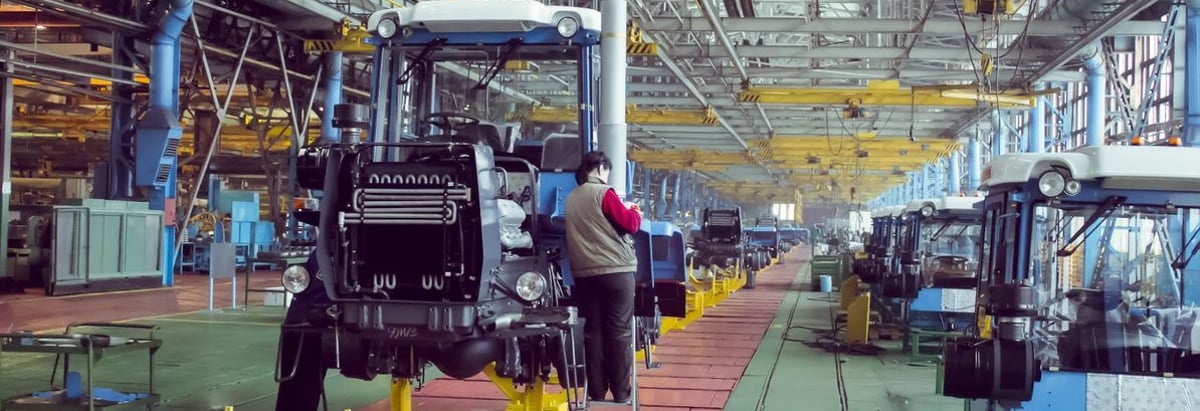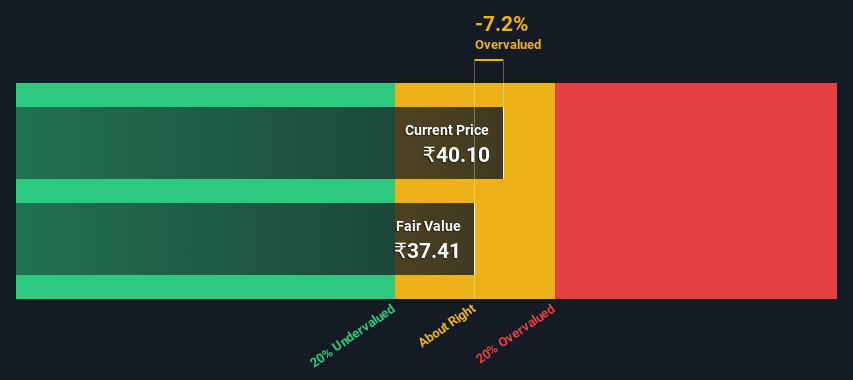A Look At The Intrinsic Value Of Jain Irrigation Systems Limited (NSE:JISLDVREQS)

Key Insights
- Using the 2 Stage Free Cash Flow to Equity, Jain Irrigation Systems fair value estimate is ₹37.41
- Current share price of ₹40.10 suggests Jain Irrigation Systems is potentially trading close to its fair value
- Jain Irrigation Systems' peers seem to be trading at a higher premium to fair value based onthe industry average of -995%
Today we will run through one way of estimating the intrinsic value of Jain Irrigation Systems Limited (NSE:JISLDVREQS) by taking the expected future cash flows and discounting them to today's value. The Discounted Cash Flow (DCF) model is the tool we will apply to do this. Before you think you won't be able to understand it, just read on! It's actually much less complex than you'd imagine.
We would caution that there are many ways of valuing a company and, like the DCF, each technique has advantages and disadvantages in certain scenarios. For those who are keen learners of equity analysis, the Simply Wall St analysis model here may be something of interest to you.
View our latest analysis for Jain Irrigation Systems
The Model
We're using the 2-stage growth model, which simply means we take in account two stages of company's growth. In the initial period the company may have a higher growth rate and the second stage is usually assumed to have a stable growth rate. In the first stage we need to estimate the cash flows to the business over the next ten years. Seeing as no analyst estimates of free cash flow are available to us, we have extrapolate the previous free cash flow (FCF) from the company's last reported value. We assume companies with shrinking free cash flow will slow their rate of shrinkage, and that companies with growing free cash flow will see their growth rate slow, over this period. We do this to reflect that growth tends to slow more in the early years than it does in later years.
Generally we assume that a dollar today is more valuable than a dollar in the future, and so the sum of these future cash flows is then discounted to today's value:
10-year free cash flow (FCF) forecast
| 2025 | 2026 | 2027 | 2028 | 2029 | 2030 | 2031 | 2032 | 2033 | 2034 | |
| Levered FCF (₹, Millions) | ₹4.01b | ₹4.44b | ₹4.86b | ₹5.29b | ₹5.71b | ₹6.15b | ₹6.61b | ₹7.08b | ₹7.58b | ₹8.10b |
| Growth Rate Estimate Source | Est @ 12.47% | Est @ 10.74% | Est @ 9.53% | Est @ 8.68% | Est @ 8.09% | Est @ 7.67% | Est @ 7.38% | Est @ 7.18% | Est @ 7.03% | Est @ 6.93% |
| Present Value (₹, Millions) Discounted @ 16% | ₹3.5k | ₹3.3k | ₹3.1k | ₹2.9k | ₹2.7k | ₹2.5k | ₹2.3k | ₹2.2k | ₹2.0k | ₹1.8k |
("Est" = FCF growth rate estimated by Simply Wall St)
Present Value of 10-year Cash Flow (PVCF) = ₹26b
The second stage is also known as Terminal Value, this is the business's cash flow after the first stage. The Gordon Growth formula is used to calculate Terminal Value at a future annual growth rate equal to the 5-year average of the 10-year government bond yield of 6.7%. We discount the terminal cash flows to today's value at a cost of equity of 16%.
Terminal Value (TV)= FCF2034 × (1 + g) ÷ (r – g) = ₹8.1b× (1 + 6.7%) ÷ (16%– 6.7%) = ₹93b
Present Value of Terminal Value (PVTV)= TV / (1 + r)10= ₹93b÷ ( 1 + 16%)10= ₹21b
The total value, or equity value, is then the sum of the present value of the future cash flows, which in this case is ₹48b. The last step is to then divide the equity value by the number of shares outstanding. Relative to the current share price of ₹40.1, the company appears around fair value at the time of writing. Remember though, that this is just an approximate valuation, and like any complex formula - garbage in, garbage out.

Important Assumptions
We would point out that the most important inputs to a discounted cash flow are the discount rate and of course the actual cash flows. Part of investing is coming up with your own evaluation of a company's future performance, so try the calculation yourself and check your own assumptions. The DCF also does not consider the possible cyclicality of an industry, or a company's future capital requirements, so it does not give a full picture of a company's potential performance. Given that we are looking at Jain Irrigation Systems as potential shareholders, the cost of equity is used as the discount rate, rather than the cost of capital (or weighted average cost of capital, WACC) which accounts for debt. In this calculation we've used 16%, which is based on a levered beta of 1.365. Beta is a measure of a stock's volatility, compared to the market as a whole. We get our beta from the industry average beta of globally comparable companies, with an imposed limit between 0.8 and 2.0, which is a reasonable range for a stable business.
Moving On:
Whilst important, the DCF calculation shouldn't be the only metric you look at when researching a company. DCF models are not the be-all and end-all of investment valuation. Instead the best use for a DCF model is to test certain assumptions and theories to see if they would lead to the company being undervalued or overvalued. For example, changes in the company's cost of equity or the risk free rate can significantly impact the valuation. For Jain Irrigation Systems, we've compiled three important items you should look at:
- Risks: For example, we've discovered 2 warning signs for Jain Irrigation Systems (1 doesn't sit too well with us!) that you should be aware of before investing here.
- Other Solid Businesses: Low debt, high returns on equity and good past performance are fundamental to a strong business. Why not explore our interactive list of stocks with solid business fundamentals to see if there are other companies you may not have considered!
- Other Environmentally-Friendly Companies: Concerned about the environment and think consumers will buy eco-friendly products more and more? Browse through our interactive list of companies that are thinking about a greener future to discover some stocks you may not have thought of!
PS. Simply Wall St updates its DCF calculation for every Indian stock every day, so if you want to find the intrinsic value of any other stock just search here.
New: Manage All Your Stock Portfolios in One Place
We've created the ultimate portfolio companion for stock investors, and it's free.
• Connect an unlimited number of Portfolios and see your total in one currency
• Be alerted to new Warning Signs or Risks via email or mobile
• Track the Fair Value of your stocks
Have feedback on this article? Concerned about the content? Get in touch with us directly. Alternatively, email editorial-team (at) simplywallst.com.
This article by Simply Wall St is general in nature. We provide commentary based on historical data and analyst forecasts only using an unbiased methodology and our articles are not intended to be financial advice. It does not constitute a recommendation to buy or sell any stock, and does not take account of your objectives, or your financial situation. We aim to bring you long-term focused analysis driven by fundamental data. Note that our analysis may not factor in the latest price-sensitive company announcements or qualitative material. Simply Wall St has no position in any stocks mentioned.
About NSEI:JISLDVREQS
Jain Irrigation Systems
Manufactures and sells micro-irrigation systems in India, Europe, North America, and internationally.
Adequate balance sheet and slightly overvalued.
Market Insights
Community Narratives



